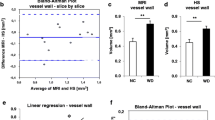Abstract
Magnetic resonance imaging (MRI) is a useful tool for non-invasive identification and characterization of atherosclerotic plaques in both basic science and clinical practice. To date, the reported studies on in vivo vascular MRI of small animals, such as mice and rats, are mainly performed on high-field micro-MR scanners, which are not always available in many academic institutions and basic research units. This study aimed to explore the possibility of generating high-resolution MR images of the atherosclerotic aortic walls/plaques of mice using a clinical 3.0 T MR scanner with a dedicated solenoid mouse coil. An atherosclerotic mouse model was first generated by feeding 8 ApoE−/− mice an atherogenic diet. MR images of the ascending aortas of these mice were then achieved using a three-dimensional black-blood turbo spin-echo sequence (repetition time TR = 4 heart echo time TE = 10 ms). The MRI displayed a clear view of the aortic lumens and the atherosclerotic lesions, which correlated significantly well with subsequent histological confirmations (linear regression analysis, r = 0.73, P = 0.04). This study demonstrated that a clinical 3.0 T MR scanner can be used for high-resolution imaging of mouse atherosclerotic lesions to some extent.



Similar content being viewed by others
References
A.J. Lusis, Nature 407, 233–241 (2000)
K.S. Meir, E. Leitersdorf, Arterioscler. Thromb. Vasc. Biol. 24, 1006–1014 (2004)
A.S. Plump, J.D. Smith, T. Hayek, K. Aalto-Setälä, A. Walsh, J.G. Verstuyft, E.M. Rubin, J.L. Breslow, Cell 71, 343–353 (1992)
S.H. Zhang, R.L. Reddick, J.A. Piedrahita, N. Maeda, Science 258, 468–471 (1992)
J. Sanz, Z.A. Fayad, Nature 451, 953–957 (2008)
Z.A. Fayad, J.T. Fallon, M. Shinnar, S. Wehrli, H.M. Dansky, M. Poon, J.J. Badimon, S.A. Charlton, E.A. Fisher, J.L. Breslow, V. Fuster, Circulation 98, 1541–1547 (1998)
F. Wiesmann, M. Szimtenings, A. Frydrychowicz, R. Illinger, A. Hunecke, E. Rommel, S. Neubauer, A. Haase, Magn. Reson. Med. 50, 69–74 (2003)
F. Kober, M. Canault, F. Peiretti, C. Mueller, F. Kopp, M.C. Alessi, P.J. Cozzone, G. Nalbone, M. Bernard, Atherosclerosis 195, e93–e99 (2007)
V. Herold, J. Wellen, C.H. Ziener, T. Weber, K.H. Hiller, P. Nordbeck, E. Rommel, A. Haase, W.R. Bauer, P.M. Jakob, S.K. Sarkar, MAGMA 22, 159–166 (2009)
J.C. Russell, Cardiovasc. Res. 59, 810–811 (2003)
W.S. Kerwin, M. Oikawa, C. Yuan, G.P. Jarvik, T.S. Hatsukami, Magn. Reson. Med. 59, 507–514 (2008)
B.M. Tsui, D.L. Kraitchman, J. Nucl. Med. 50, 667–670 (2009)
V. Amirbekian, J.G. Aguinaldo, S. Amirbekian, F. Hyafil, E. Vucic, M. Sirol, D.B. Weinreb, S. Le Greneur, E. Lancelot, C. Corot, E.A. Fisher, Z.S. Galis, Z.A. Fayad, Radiology 251, 429–438 (2009)
W.D. Gilson, D.L. Kraitchman, Methods 43, 35–45 (2007)
A.L. Alexander, H.R. Buswell, Y. Sun, B.E. Chapman, J.S. Tsuruda, D.L. Parker, Magn. Reson. Med. 40, 298–310 (1998)
H. Jara, B.C. Yu, S.D. Caruthers, E.R. Melhem, E.K. Yucel, Magn. Reson. Med. 41, 575–590 (1999)
Acknowledgments
This study was supported in part by NIH R01 HL078672 grant and Dr. Xubin Li was supported by the State Scholarship Fund of China Scholarship Council. We thank Ms. Tiffany Blair, BS, for her editorial assistance, and Mr. Tyler Mckay, BS, for his assistance with histological acquisitions.
Author information
Authors and Affiliations
Corresponding author
Rights and permissions
About this article
Cite this article
Li, X., Gu, H., Feng, H. et al. Clinical 3.0 T Magnetic Resonance Scanner to Be Used for Imaging of Mouse Atherosclerotic Lesions. Appl Magn Reson 39, 401–407 (2010). https://doi.org/10.1007/s00723-010-0174-4
Received:
Revised:
Published:
Issue Date:
DOI: https://doi.org/10.1007/s00723-010-0174-4




